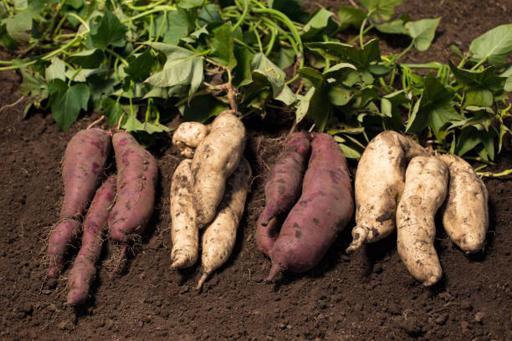Yam
Dioscorea spp.
Also known as: True Yam, White Yam, Yellow Yam

Growing Information
Growth Habit: Vine
Climate Requirements: Prefers tropical and subtropical climates with temperatures between 25–30°C and a growing season of 8–12 months.
Soil Requirements: Well-drained, loamy soils with a pH of 5.5–6.5.
Water Requirements: Requires consistent moisture, particularly during tuber formation, but can tolerate short periods of drought.
Planting Instructions: Planted using tuber pieces or small whole tubers, spaced 1 meter apart in rows, with planting depth of 10–15 cm.
Harvesting Information: Harvested when the leaves begin to yellow, typically 8–12 months after planting.
Characteristics & Benefits
Plant Characteristics: Yam is a vine that produces large, starchy tubers. It is known for its rough, scaly skin and is an important staple food in many tropical countries.
Nutrient Content: High in carbohydrates, potassium, fiber, and vitamin C.
Health Benefits: Supports heart health, aids digestion, and provides a good source of energy.
Yield Information: Average yield is 15–30 tons per hectare.
Uses & Distribution
Culinary Uses: Used boiled, roasted, or fried. Can be mashed, added to stews, or used in soups.
Industrial Uses: Used for starch production and as an animal feed.
Native Range: Africa, Asia, and Central America.
Current Distribution: Grown in tropical regions worldwide, with major producers including Nigeria, Ghana, and China.
Pest & Disease Management
Common Pests: Yam beetle, aphids, and caterpillars.
Diseases: Yam mosaic virus, fusarium wilt, and root rot.
IPM Practices: Crop rotation, removal of infected plants, and use of disease-resistant varieties.
Market Value: $220.00
Research & References
Studies and Articles: Research on improving yam yield and disease resistance.
Bibliography: The Yam Crop: Cultivation and Uses, 2022.
Comments
Add CommentNo comments yet. Be the first to comment!